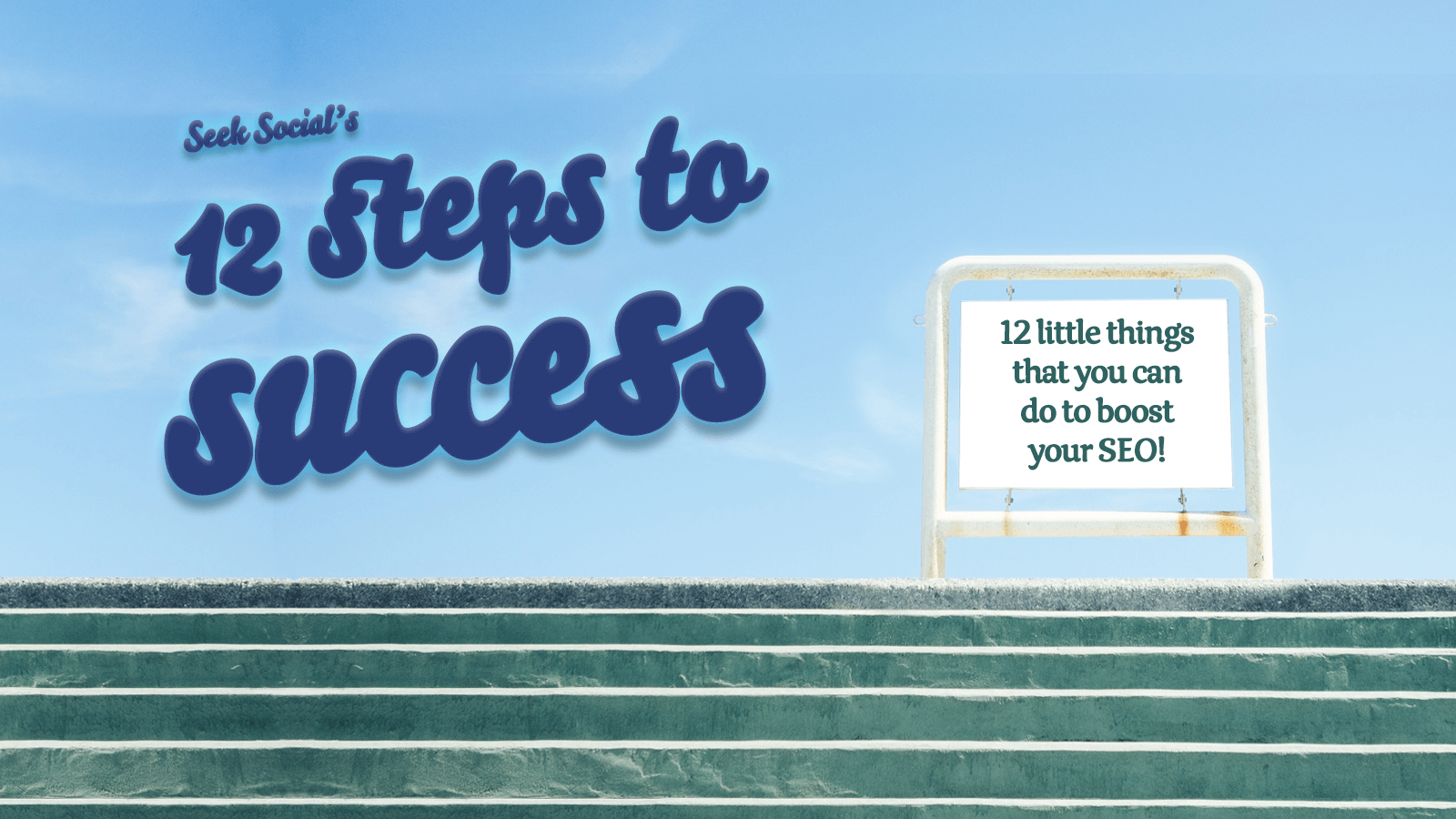11 January 2021
A Top Digital Agency’s 12 Steps to SEO Success!
Before we get started – while the advice in this blog is certainly very useful, the Seek Social team have produced an improved and updated version of this blog for 2022 and beyond – to check that updated version out, click here!
There’s no getting around it, 2020 was a rough ride for everyone – especially if you own a business – however, we now have the chance for a fresh start in the new year. To that end, the staff at Seek Social – Bury’s top digital agency – have devised a little something that we hope will help you prepare your business website for a bounceback year in 2021.
 Our top digital agency knows that this to-do list of twelve tasks can really help a site rise through the search engine rankings, making your business more visible online, and in turn bringing in more customers and more chances to generate the conversion actions that matter to you.
Our top digital agency knows that this to-do list of twelve tasks can really help a site rise through the search engine rankings, making your business more visible online, and in turn bringing in more customers and more chances to generate the conversion actions that matter to you.
However, Bury’s top digital agency also know that – like ourselves – you don’t have time to spend every hour of every day perforning SEO tasks. That’s why we’ve designed each part of the list to either be something quick and easy to complete, or something that’s easy to put down halfway through and come back to later. So, without further ado, let’s get into it!
Step 1: Google Analytics Set-Up
 We start out with something that isn’t really an SEO task, but that is essential to performing good SEO. Bury’s top digital agency are firm believers in the importance of measuring and analysing the results produced by any SEO work we do. We believe one of the reasons why our methods are as effective as they are is because we include this analysis step – and in the SEO industry you can’t do that analysis without setting up Google Analytics – so at this top digital agency, that’s the first job on our list.
We start out with something that isn’t really an SEO task, but that is essential to performing good SEO. Bury’s top digital agency are firm believers in the importance of measuring and analysing the results produced by any SEO work we do. We believe one of the reasons why our methods are as effective as they are is because we include this analysis step – and in the SEO industry you can’t do that analysis without setting up Google Analytics – so at this top digital agency, that’s the first job on our list.
We won’t go into the process here except to say that you’ll need a Gmail account before you go to ‘analytics.google.com’ to set up your account – the reason being that the team at Bury’s top digital agency put together an in-depth guide to Google Analytics not so long ago that will walk you through the entire setup process from start to finish, and tell you way more than we have space for today. Part 1 of that guide covered setup, while part 2 and part 3 are packed with extra info for those looking to learn more!
Step 2: Google Search Console Set-Up
We continue laying the groundwork on day two. If you read our blog on Sitemaps than you’ll know that keeping Google up to speed with new developments and new content on your site plays a big role in your SEO success. The way you do that is by requesting that Google re-analyse your site, and – as any top digital agency should know – the quickest and easiest way to do that is via the ‘Sitemaps’ tab in Google Search Console.
Once we finished the three-part Google Analytics guide mentioned above, we moved straight on to Google Search Console – so again our top digital agency already has a great three-part guide that will show you how to do everything you need here. Part 1 of that guide deals with the initial account setup work, with part 2 and part 3 once more providing a more complete ‘guided tour’ of the platform and its essential functions.
The Seek Social team found the ‘Sitemaps’ area of GSC important enough to spin it off into an entire blog post of its own, so for more information on how to correctly submit a sitemap using Google Search Console – and just why it’s important – take a look at our in-depth guide to sitemaps!
 Step 3: Keyword Check
Step 3: Keyword Check
‘Keywords’ are what make search engines work. They are the key element that search engines use to determine what page goes where in the rankings. As a result, you need to know ‘good’ keywords from ‘bad’ ones, as well as what words and terms are being used most often on your webpages.
Finding and using good keywords is a job for SEO pros like the team you’ll find at our top digital agency, but – especially if you’ve outsourced your content writing or you’re not happy with your SEO results thus far – this simple keyword check is a great way to find out if the content you have is capable of doing the job you want it to do… If it’s working with or working against your wider SEO strategy. All you have to do is find yourself a text analysis tool (there are plenty of free web-based ones out there that will do the job just fine), paste in a page’s content and just see which words and combinations come out on top.
If the page has already been optimised then you should see its keyword as one of the top results, if not then you’re looking for words and terms that are at least related to what the main focus of the page is supposed to be. These could be good keywords to use too, but it’s best to consult a top digital agency like ourselves to know for sure. In any case, if the results you get back have nothing to do with the main focus of the page, then you know that you have a problem and that your content is holding you back.
 Step 4: Paragraph Check
Step 4: Paragraph Check
Human beings have short attention spans. We don’t like to get dragged unexpectedly into big tasks that will take a long time to complete. This is partly why the team at Bury’s top digital agency have broken this list down as we have, and it’s the reason why people are put off reading something when they see the dreaded ‘textwall’ online.
Because of this, you can gain an SEO bonus if you use shorter paragraphs of around 100 words. This breaks your text up and provides lots of handy stopping points where readers can put the text down for now and pick it back up later. Not only is this preferable for readers, but Bury’s top digital agency knows that a text that’s presented in ‘bite size’ chunks like this is more likely to be read and provide value to it’s visitors – and now so do you. The important thing to realise however, is that Google knows this too – and because Google knows that people are more likely to stay, and read, and find such pages useful, it grants them a bonus in the rankings. You can get this bonus for your pages too – but only if you keep your paragraphs short.
 Step 5: Add Images
Step 5: Add Images
In addition to keeping the length of your paragraphs in check, the staff at Bury’s top digital agency also know that there’s another thing you can do to break your text up and make it more appealing for the reader – add images. Again though, we aren’t the only people who know this – the search engines have also noticed a trend where human users tend to stay on pages with good quantities of both text and images.
As a result search engines tend to prefer such a page over a page that leans too heavily on either text or images, and will give it a higher ranking. This top digital agency therefore knows that because of this ‘preference’ demonstrated by the search engines, there’s an SEO bonus to be had if you can strike the right ‘text-to-images’ balance with your page. Likewise, we also know that if you aren’t trying to achieve that balance and producing pages that are overly image-heavy or text-only – even if your paragraphs are the right length – you’re missing out on an opportunity to improve your SEO.
So, the advice from our top digital agency is to take some time and make sure that every page on your site includes at least one image, and that it’s well positioned and fits in with the overall layout of the page. After all, an image that’s been added to a page in a slapdash fashion will hurt the overall layout and look of your page – possibly even making you look unprofessional too – and that will make a lot of people turn away from your message.
Step 6: Add Alt Texts
While you’re adding those images, it’s a good idea to ensure that you’re assigning good ‘alt texts’ to them as well. As any top digital agency should be able to tell you, an ‘alt text’ is a piece of text used by things like screen readers to verbally describe an image to a visually impaired visitor. If you can include your keyword in your alt text for an image then again there’s an SEO bonus on offer, as for a search engine, this only reinforces the idea that your page’s content is built around a single, well defined topic.
Be very careful when you do this though. Again, any top digital agency should also tell you that using alt texts that do not represent the image they’re attached to, just to gain that SEO bonus is highly unethical – providing a truthful description of the image is the very purpose of an alt text after all. The rule in use at this top digital agency when it comes to alt texts – and the one that we’d recommend to you – is quite simply ‘say what you see’. If you do that then you can’t go wrong – and if you can find a way of expressing what you see that also includes your keyword then so much the better!
 Step 7: SEO Titles
Step 7: SEO Titles
You may not know it, but Bury’s top digital agency can tell you – if you’ve ever used a search engine, you’ve seen an SEO title before. After you run a search you’re obviously presented with the results, and the most prominent part of each individual result is a big blue link that you click to go to the page in question. That big blue link is the SEO title, and like many of the various elements of a webpage, it can be optimised.
To what extent this is possible, and exactly how you go about it will depend on a number of factors – ranging from what your keyword is, to the name of your company or website, what the page is about, and how you phrase things. There are a myriad of variables in play when optimising an SEO title and it’s the first thing that users will see when your page is returned in their results – for that reason we’d advocate putting SEO title optimisation work in the hands of experts like the team at our top digital agency.
Nevertheless, there is one key thing you can do to evaluate the quality of the SEO titles you have right now, and that’s to see if they include your keyword. If they do, then it’s great news – if they don’t however, your SEO titles are not going to be helping your ranking at all, and you’re missing out on another part of your website that could be earning you a nice SEO bonus if done correctly.
 Step 8: Meta Descriptions
Step 8: Meta Descriptions
At their core, Bury’s top digital agency would describe meta descriptions as a longer-form variant of an SEO title. The main difference is that instead of announcing and introducing your page – which is usually done with the SEO title – with the meta description you’re describing to your potential audience what they can expect to find should they click your link, and trying to persuade them to do so.
As we’ve mentioned in the previous point, because the meta description is one of the first things a prospective visitor will see in relation to your site, again we’d say that this is work best left in the hands of professionals like the team at our top digital agency. However, once again there is a quick test that you can perform to see if your meta descriptions are helping your SEO score, and once again in that test you’re looking for your page’s keyword. If it’s present then – while an expert from our top digital agency might still be able to make an improvement – your meta description is making a solid contribution to your ranking. If it isn’t present then the meta description is missing a crucial element, and you should look to remedy that as soon as possible.
Step 9: Internal Links
‘Internal links’ are links on a page that lead to another page within the same web domain – links that go from one page on your site directly to another page on your site. If your page doesn’t contain any internal links then the team at this top digital agency know that you’re missing out – not only when it comes to SEO but also on an opportunity to send people to the parts of your site where you want them to be.
Links are such a powerful tool for SEO that again, it’s best to have experts from a top digital agency handle the fine details of ‘what links to where’, so you can get the best results on the pages that really matter. Yet again though, your task here is to check the current state of things – go through your pages and just see if they each have at least one internal link on them. If they do then that’s great – your site is pulling its weight in this area. if not however, then that’s another area that you (or a top digital agency like Seek Social) need to address as soon as possible.
 Step 10: External Links
Step 10: External Links
‘External links’ are links on a page that lead to a page on another web domain – links that go from a page on your site to a page on another site. Just like with internal links above, each page on your site should contain at least one external link, and your task with this item is to find out whether or not they do.
As above, if they do then the page is doing it’s best in this area from the standpoint of SEO score – although experts like the team at Bury’s top digital agency will almost certainly be able to help you refine and improve your linking strategy to draw traffic and the attention of search engines to your most important pages. If however you find pages that are missing external links, then this will be holding that page back from ranking as well as it otherwise might, and is a priority issue to be addressed by those responsible for your SEO.
Step 11: Off Site Backlinks
A ‘backlink’ is a link on another site that leads to a page on your site. As a result it might seem like they can’t really help your SEO, but this top digital agency knows that this is definitely not the case! Like the other links that we’ve spoken about above, backlinks are indeed a powerful SEO tool – not least because they a key factor in determining your ‘Page Authority’ (or ‘PA’) and ‘Domain Authority’ (or ‘DA’). These two ‘authority’ scores are essentially a measure of how much the internet believes that your page or site as a whole ‘knows what it’s talking about’, and is a source of reputable information.
Search engines put a good amount of stock in these authority scores, and as a result pages with higher scores rank above similar pages with a lower PA and DA – you could almost see it as the tiebreaker in a search engine’s ranking system. The key takeaway though, is that – as Bury’s top digital agency can tell you – increasing your PA and DA will improve your ranking.
How do you create backlinks though? Well, again that’s probably best left to a top digital agency like us – as if you do it wrong you can end up doing more harm than good. However, you can certainly have a look and see how you’re doing in this regard without any risk. Search for pages on your site and see if they are found on any third-party sites in the results. If they are, then great – but if you can’t find any then your site might need some help from experts like Seek Social, creating backlinks and building your authority.
 Step 12: Social Media
Step 12: Social Media
Our top digital agency knows that another weapon in your SEO arsenal is Social Media, which works more from an awareness point of view than anything else. Anytime you have a new blog post out, a product offer, or basically anything that you want to promote via your website, you should be posting about it on Social Media too, and including a link to it in your post.
Unfortunately on social media these links are usually ‘no follow’ backlinks which means they won’t help your PA and DA like the backlinks discussed earlier – but that doesn’t mean that the search engines aren’t looking at what’s happening on social media and factoring it into their rankings – again, as a top digital agency, we know that indeed they are. The more likes, comments and clicks you can get the more you’ll help your SEO, as well as your social media presence. The returns for SEO maybe aren’t as great as the other tasks on this list, but every little help – and if you aren’t doing this then again you’re missing out.
The Final Word From Our Top Digital Agency
We really hope the tips we’ve given above help you get to grips with how your site’s performing from an SEO standpoint and we hope that you get favourable results. However, if you don’t all is not lost – it just means that it’s time to call on the team at Bury’s top digital agency, Seek Social. And finally, since this is our first blog of the new year, we would of course want to wish all of our staff, our awesome clients, and anyone that’s reading this a Happy New Year – here’s to a prosperous 2021!

